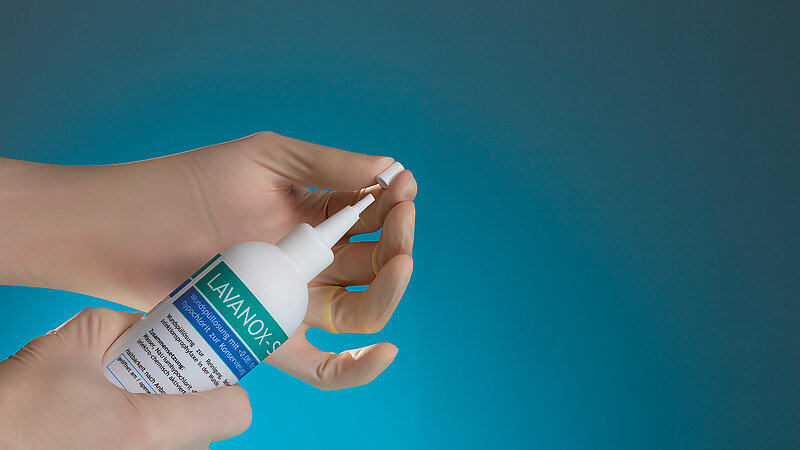Product description
LAVANOX-Serag® Wound Irrigation Solution and LAVANOX-Serag® Wound Spray are medical devices based on an electrochemically activated mineral salt solution with <0.08% sodium hypochlorite/hypochlorous acid (NaOCl/HOCl). The sodium hypochlorite/hypochlorous acid contained in LAVANOX-Serag® is a reliable and effective preservative and makes LAVANOX-Serag® a well-tolerated and efficient wound irrigation solution. The mechanical effect of LAVANOX-Serag® ensures a thorough cleansing of the wound and surrounding area, thus creating a milieu that promotes healing. It also eliminates unpleasant wound odours quickly and reliably.
The preservative sodium hypochlorite/hypochlorous acid (NaOCl/HOCl) reduces the growth of Gram-negative and Gram-positive bacteria (e.g. Pseudomonas aeruginosa, MRSA and MRE), viruses and fungi in the solution.
Indications for use
LAVANOX-Serag® is used for the cleansing, moistening, mechanical decontamination and prevention of infection of the wound; it is suitable for both acute and chronic wounds, especially contaminated and dirty wounds with a high risk of infection.
LAVANOX-Serag® helps to remove biofilms and fibrinoid residues efficiently and gently and enables a relatively painless removal of dressings that are encrusted and difficult to detach. LAVANOX-Serag® Wound Irrigation Solution 1000 ml is suitable for use in negative pressure wound therapy (NPWT).
Effective mechanical debridement
The electrolysis process reduces the cluster size of the water from 15-20 molecules to approx. 5-7 molecules, thereby greatly reducing the surface tension.1,4 This enables effective cleaning in even the most difficult to access wound areas.1,4 This mechanical rinsing effect allows LAVANOX-Serag® to significantly reduce the microbial load of the wound and achieve an effective and fast cleaning performance. 8 Furthermore, if used regularly, it can prevent an infection of the wound.
Application
The wound should first be cleaned to remove dirt, blood and residues. For this, the affected areas are rinsed with LAVANOX-Serag® or moistened with several puffs of spray.
Rinsing with another solution is not necessary after using LAVANOX-Serag®. There are no restrictions regarding the frequency and duration of use. The application of LAVANOX-Serag® does not cause any irritation or itching and only minimal pain.
Composition
Water, <0.08% sodium hypochlorite/hypochlorous acid (electrochemically activated mineral salt solution)
Mechanism of action
The preservative sodium hypochlorite/hypochlorous acid (NaOCl/HOCl) is an effective oxidant that splits off and releases oxygen (O). This released oxygen impairs the permeability of the cell wall of pathogens such as bacteria (including Pseudomonas aeruginosa, MRSA/MRE), viruses and fungi and ensures an excellent mechanical debridement due to the reduced surface tension. Microorganisms can no longer withstand the osmotic pressure and the microbial load is reduced.1,3,4
Once the oxygen has been split off from the sodium hypochlorite/hypochlorous acid, the substance reacts back to its natural starting components, water and salt.4
Sodium hypochlorite/hypochlorous acid is also produced by the body itself as a defence against microorganisms in lysosomes and supports the body's own self-healing process.
The concentration of “active chlorine” is thereby sufficiently low to facilitate an excellent wound healing milieu without damaging human tissue.3
Effectiveness
The antimicrobial effectiveness of two wound irrigation solutions containing the preservative NaOCl/HOCl was examined in the laboratory for the two test microbes S. aureus and E. hirae The irrigation solution with 50/50 ppm achieved a significantly weaker antimicrobial efficacy (reduction of less than log-3) than the more highly concentrated solution with 800 ppm.7
Tolerability
Irrigation solutions containing the preservative NaOCl/HOCl (800 ppm) are very well tolerated. This excellent tolerability was demonstrated in cytotoxicity analyses and in the HET-CAM test (chicken embryo test).1
The allergy test (patch test) shows that there is no sensitisation and that no toxic-irritative intolerances occur. 1 In the Consensus on Wound Antisepsis 2018 9 irrigation solutions with NaOCl/HOCl are classified as being the first choice for a wide range of applications and for the decontamination of acute and chronic wounds.
Cells in healthy tissues have endogenous protective mechanisms against the redox processes taking place with NaOCl/HOCl and are not damaged. 4
A prospective clinical comparative study carried out in 2019 demonstrated that irrigation solutions containing the preservative NaOCl/HOCl (800 ppm) are comparable with respect to pain perception and tolerability to the gold standard wound irrigation solution based on 0.04% polyhexanide.8
Product range
| Art.No. | PIP-code | Quantity | PU | |
|---|---|---|---|---|
| 017025 | 11869876 | Plastic bottle Irrigation 250 ml | 1 | |
| 017027 | 18824724 | Plastic bottle Irrigation 1000 ml | 1 |
| Art.No. | PIP-code | Quantity | PU | |
|---|---|---|---|---|
| 017043 | 11869899 | Plastic bottle Spray 75 ml | 1 |
Literature
1 Brill FHH. Data on file. 2013
2 Kammerlander G, Assadian O, Eberlein T, Zweitmuller P, Luchsinger S, Andriessen A. A clinical evaluation of the efficacy and safety of singlet oxygen in cleansing and disinfecting stagnating wounds. J Wound Care. 2011 Apr;20(4):149-50
3 Kramer A. Wundantiseptik. ARS MEDICI. 2016 (9): 419-426
4 Lorberth J, Massa W. Zu den chemischen Grundlagen der Wirkung von Steralythen. Wund Management 2012 (3): 52-54
5 Möller A, Splieth B, Schmitz M, Eberlein T. Produkte auf Basis elektrochemischer Aktivierung (ECA) im erweiterten medizinischen Einsatz. Medizin & Praxis. 2016
6 Anna-Lena Severing, Julian-Dario Rembe, Verena Koester, Ewa K. Stuermer. Safety and efficacy profiles of different commercial sodium hypochlrite/hypochlorous acid solutions (NaClO/HClO): antimicrobial efficacy, cytotoxic impact and physiochemical parameter in vitro, Journal of Antimicrobial Chemotherapy 2018 Nov: 356-372
7 Brill FHH. Data on file. 2018
8 Eberlein T, Data on file. 2019










